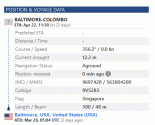The ships timeline as it stands from the initial NTSB investigation ….
•
About 12:39 a.m.: The ship left the Seagirt Marine Terminal.
•
By 1:07:00 a.m.: The ship had entered the Fort McHenry Channel.
•
01:24:59 a.m.: Numerous audible alarms were recorded on the ship’s bridge audio. At about the same time, the VDR stopped recording ship system data but was able to keep recording audio using a different power source.
https://edition.cnn.com/2024/03/26/us/baltimore-bridge-collapse-what-we-know
•
01:26:02 a.m.: The VDR resumed recording ship system data. During this time, steering commands and orders regarding the rudder were captured on audio.
•
01:26:39 a.m.: The ship’s pilot made a general very high frequency (VHF) radio call for tugboats in the vicinity to help the vessel. Around this time, the pilot association dispatcher contacted the Maryland Transportation Authority duty officer about the blackout, according to transit authority data.
•
Around 01:27:04 a.m.: The pilot ordered that the ship’s port anchor be dropped and issued additional steering commands.
•
Around 01:27:25 a.m.: The pilot issued a radio call over the VHF radio, reporting that the vessel had lost all power and was approaching the bridge. Around this time, the transit authority duty officer radioed two of its units — one on each side of the bridge — that were already on scene and ordered them to close traffic on the bridge. All lanes were then shut down.
•
Around 01:29 a.m.: The ship’s foward speed was recorded at just under 8 miles per hour. From this moment until around 1:29:33, the VDR audio recorded sounds consistent with a crash at the bridge. MDTA dash cameras show the bridge lights extinguishing.
•
01:29:39 a.m.: The pilot radioed the US Coast Guard to report the bridge was down.





